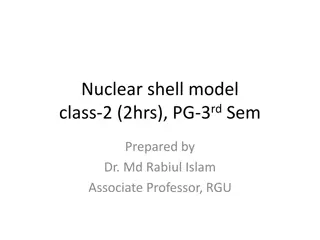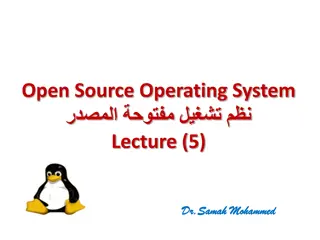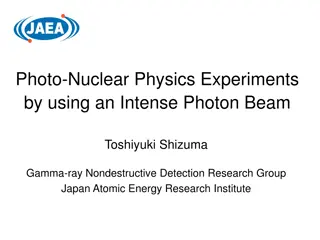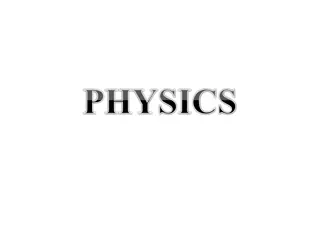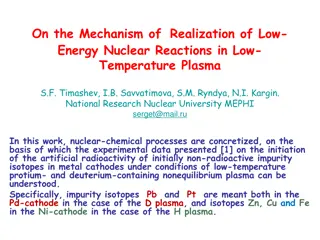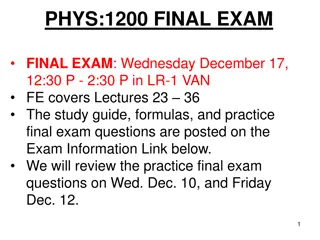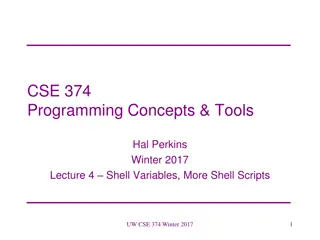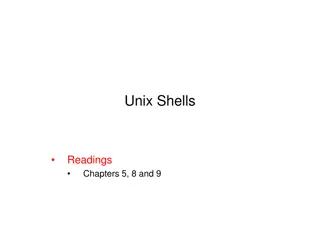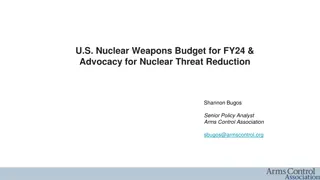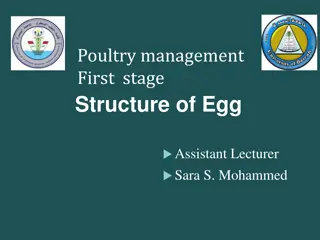Shell Model Study in Nuclear Physics
In this nuclear physics study, the shell model approach was used to explore the A130 region, focusing on shapes, symmetries, and shell evolution in nuclei. Collaborators and experimental insights were also highlighted, along with discussions on proton-neutron interactions, tensor forces, and effective interactions in heavy N=Z nuclei. Specific topics covered include chiral partner bands, shell evolution along Sn isotopes, and systematic studies of Sb isotopes. The development and application of the VMU interaction model, as well as interpretations of experimental data, were key aspects of the research.
Download Presentation

Please find below an Image/Link to download the presentation.
The content on the website is provided AS IS for your information and personal use only. It may not be sold, licensed, or shared on other websites without obtaining consent from the author.If you encounter any issues during the download, it is possible that the publisher has removed the file from their server.
You are allowed to download the files provided on this website for personal or commercial use, subject to the condition that they are used lawfully. All files are the property of their respective owners.
The content on the website is provided AS IS for your information and personal use only. It may not be sold, licensed, or shared on other websites without obtaining consent from the author.
E N D
Presentation Transcript
Shell-model study for the A130 region Yutaka Utsuno Advanced Science Research Center, Japan Atomic Energy Agency Center for Nuclear Study, University of Tokyo Shapes and Symmetries in Nuclei: from Experiment to Theory (SSNET 17) Gif-sur-Yvette, France, November 6-10, 2017.
Collaborators Noritaka Shimizu (CNS, Tokyo) Michio Honma (Aizu) Takaharu Otsuka (RIKEN/Tokyo/Leuven/MSU) Experimental collaborators Costel Petrache (CSNSM) and his collaborators, for N=80 isotones (I will not talk on this issue today because of limiting time.)
Realm of the shell model g7sdh11 (this study) heaviest N=Z nucleus? super-allowed decay p-n pairing triaxiality chiral bands shell evolution along Sn isotopes f5pg9 (2000s) pf (1990s-2000s) sd (1980s)
Outline of this talk Large-scale shell-model calculations for the g7sdh11 (50 N(Z) 82) shell 1. Systematic study of Sb (Z=51) isotopes proton shell evolution along the Sn isotopes shell evolution vs. correlation 2. Chiral partner bands in 128Cs one of the best candidates for chiral partner bands first full shell-model calculations for this case
1. Shell evolution Due to proton-neutron interaction node = n j >=l +1/2 node n j<=l-1/2 central tensor node = n j>=l+1/2 This concept is well implemented by the VMUinteraction that consists of a phenomenological Gaussian central force plus the + tensor force. T. Otsuka, T. Suzuki, M. Honma, Y. Utsuno et al., Phys. Rev. Lett. 104, 012501 (2010).
Sb isotopes: tensor-force shell evolution? Interpretation of the 7/2+and 11/2-levels in Sb isotopes Single-particle levels g7/2and h11/2 Coupling to collective states 11/2-: 3 ??7/2 J. P. Schiffer et al., Phys. Rev. Lett. 92, 162501 (2004) T. Otsuka et al., Phys. Rev. Lett. 95, 232502 (2005)
Effective interaction proton-proton interaction and neutron-neutron interaction Semi-empirical interaction by M. Honma et al. Matrix elements are fitted to experimental energies of Sn isotopes (for n-n) and N=82 isotones (for p-p) M. Honma et al., RIKEN Accel. Prog. Rep. (2012). M. Honma et al., RIKEN Accel. Prog. Rep. (2016).
Effective interaction proton-neutron interaction Sb Based on a version of the VMUinteraction that was adopted for the sd-pf shell calc. [Y. Utsuno et al., Phys. Rev. C 86, 051301(R) (2012)] Including overall scaling factor 0.84 to well reproduce proton separation energies of Sb isotopes Single-particle energies Taken from experimental levels in 133Sb (proton) and 131Sn (neutron) The single-particle levels on top of 100Sn is a prediction!
Evolution of the energy levels in Sb 11/2-1and 5/2+1levels measured from 7/2+1 Non-monotonic evolution is reproduced. 2.25 MeV full shell-model results vs. estimate from effective single- particle energies (ESPE) of two kinds ESPE1: filling configuration at N=64, i.e., no correlation included ESPE2: (j) Sn(0+1), i.e., n- n correlation included
Single-particle energy and correlation Consider the change from N=64 (to 82): 2.215 MeV in expt. ESPE1: no correlation (6, 8, 0, 0, 0) for occupation in (d5/2, g7/2, h11/2, s1/2, d3/2) tensor only: 1.93 MeV central + ls + tensor: 1.93 MeV ESPE2: n-n correlation included (4.76, 5.91, 1.74, 0.69, 0.91) tensor only: 1.21 MeV central + ls + tensor: 1.38 MeV shell-model calculation: full correlation included central + ls + tensor: 1.89 MeV n(h11/2)=12 occupation from N=64 to 82 n(h11/2)=10.3 T. Otsuka et al., Phys. Rev. Lett. 95, 232502 (2005). Canceling n-n and p-n correlation energies amounting to 500 keV The evolution of the level is still dominated by the tensor force.
Single-particle strength for Sb Shell model 7/2+ 11/2- N Conjeaud et al. Schiffer et al. Conjeaud et al. Schiffer et al. 62 0.94 0.99 0.4 0.84 64 0.85 1.10 0.93 66 0.81 0.95 0.53 0.97 68 0.79 0.88 0.63 0.99 70 0.7 1.13 0.63 1.12 Experimental data exist. 72 0.84 0.98 0.49 1.00 74 0.74 1.00 0.75 1.12 (3He, d): M. Conjeaud et al., Nucl. Phys. A 117, 449 (1968). ( , t): J. P. Schiffer et al., Phys. Rev. Lett. 92, 162501 (2004). Absolute values are sensitive to the optical potential adopted. Is there an alternative way to probe the single-particle strength?
Evolution of in Sb from N=70 to 82 magnetic moment: sensitive to the degrees of mixing 7/2+1 Particle-vibration coupling increase of configuration mixing towards mid-shell N=70 N=82 11/2-1 Expt. Calc. effective nucleon g factor adopted: isovector shift gl(IV)=0.1, spin quenching factor 0.6 115Sb 5.53(8) 5.53 117Sb 5.35(9) 5.63 (133Sb)=2.97 (calc.) vs. 3.00(1) (expt.) c.f. 7.18 for the single-particle value
2. Chiral doublet bands First proposed by Frauendorf and Meng in 1997 A 130 region: the region of most extensive study Triaxiality favored 1? 11/2 1config. favored ? 11/2 Usual theoretical tools Chart of observed doublet bands Tilted axis cranking (TAC) Particle-rotor model (PRM) Aim of this study SM calculations for chiral bands Including various degrees of freedom, e.g. -vibration Starosta and Koike (2017)
Doublet bands Chiral bands Selection rule Experiment Symmetry consideration M1 M1 M1 M1 M1 M1 T. Koike, K. Starosta, I. Hamamoto, Phys. Rev. Lett. 93, 172502 (2004). 128Cs: a best candidate E. Grodner et al., Phys. Rev. Lett 97, 172501 (2006).
Diagonalizing SM Hamiltonian: dimension M-scheme dimension for M =9+ N=71 3.5 1011 5.9 1012 4.9 1013 2.2 1014 N=73 7.6 1010 1.3 1012 1.1 1013 4.9 1013 N=75 9.1 109 1.5 1011 1.3 1012 5.9 1012 N=77 5.3 108 9.1 109 7.6 1010 3.5 1011 Z=55 (Cs) Z=57 (La) Z=59 (Pr) Z=61 (Pm) 128Cs: limit of today s capability : Lanczos : MCSM Current limit: 1011 KSHELL, ANTOINE, Here we use the KSHELL code made by N. Shimizu, running on the K supercomputer in Japan. Courtesy of N. Shimizu
128Cs: energy levels 1? 11/2 1states from the calculated levels Identifying ? 11/2 Comparing the occupation numbers between 128Xe and 128Cs The lowest two states with the required occupancy for each spin-parity energy measured from 9+ level spacing: suppressed compared to expt. data by 20%
128Cs: transitions SM calc. Expt. (Grodner et al.)
128Cs: moments No experimental data available, but worth calculating to see whether the doublet bands are the partners. g factors Similar between yrast and side Nearly constant around 0.4-0.5 Seems consistent with chiral Q moments Similar between yrast and side Rather stable for yrast Fluctuating by 25% for side
Future works for the study of chiral bands To investigate the nature of the doublet bands in 128Cs Calculating the overlaps 128Cs,??1 ?? 11/2 128Xe,??2, where ?? 11/2 ??1and ??2denote the states of 128Cs and 128Xe, respectively, and stands for the coupling of a proton particle and a neutron hole. If ??and ??are orthogonal, of large overlaps should be 2 11 2~8. To refine the effective interaction Is it easy to enlarge the spacing of neighboring levels? To check medium-spin (R 10) states in 128Xe
Summary We have studied nuclear structure in the A 130 region with large- scale shell-model calculations in the full g7sdh11 (50 N(Z) 82) model space. Single-particle degrees vs. collectivity Fitted interaction for p-p and n-n, and a simple VMUinteraction for p-n 1. Shell evolution in Sb isotopes Although the 11/2-levels are not pure proton single-particle levels (as magnetic moments suggest), the evolution is dominated by the tensor-force driven shell evolution. 2. Chiral bands in 128Cs First full shell-model results: full correlation in the model space Experimental behaviors are reasonably reproduced. Future work: calculating spectroscopic amplitudes





